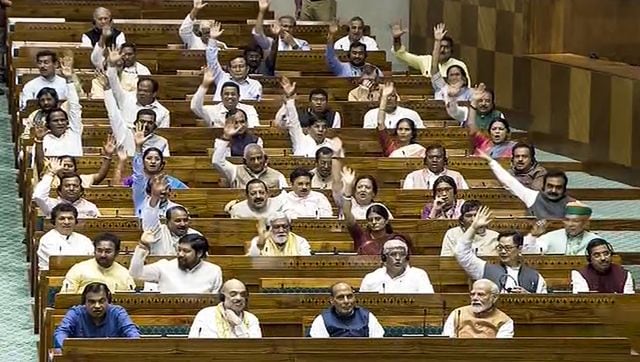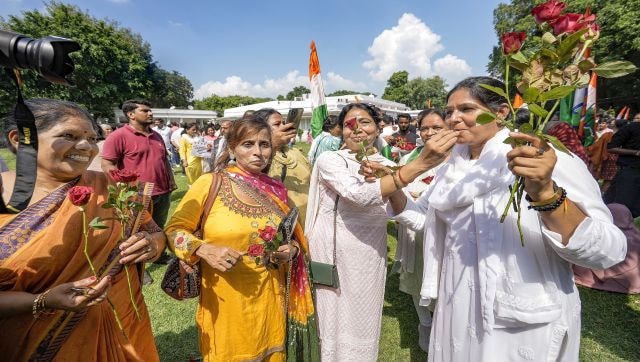After hours and hours of debate on Wednesday (20 September), the Lok Sabha passed The Nari Shakti Vandan Adhiniyam — The Constitution (One Hundred and Twenty-Sixth Amendment) Bill, 2023 – which reserves 33 per cent quota for women in Lok Sabha and state/UT legislative Assemblies.
At the final count, the lower house had passed the women’s reservation bill with 454 members voting in favour and two against it. Prime Minister Narendra Modi was present during the voting on the bill, which was the first to be passed in the new Parliament building. Today (21 September), the bill is likely to pass the Rajya Sabha hurdle and become a law after the President’s assent.
However, don’t expect to see changes in the Assemblies or Parliament immediately. The 33 per cent quota, in fact, won’t come into play at least until 2029. Why? This is because reservation has been made contingent on the delimitation exercise. The new bill, introduced by the BJP-led Centre, has inserted one article – 334A – which clearly states: “Reservations shall come into effect after delimitation is undertaken after the relevant figures for the first census have been published. Rotation of seats for women shall take effect after each subsequent exercise of delimitation.”
In his speech, speaking for the legislation, Home Minister Amit Shah even said that the “delimitation process” to decide which constituency is to be reserved for women will be “transparent”, and will be carried out by a delimitation commission.
This effectively means that the fulfilment of the women’s reservation bill is highly dependent on the delimitation process that is tied to a fresh Census. As it is so important now, we explain what this procedure is and why it is relevant.
What is delimitation?
The Election Commission defines delimitation as the “process of fixing limits or boundaries of territorial constituencies in a country or a province having a legislative body.”
In simple words, it is the process to allot seats and have representatives based on the population. Ideally, each representative — a member of the Parliament or the state legislature — is supposed to represent an equal number of the population in the house. To achieve this, the Constitution requires that the delimitation is done after a Census (an official count of a population arrived at through a survey).
Delimitation in India is a constitutional exercise; it is conducted as per the procedure described in Article 82 of the Constitution.

As per law, after the Parliament enacts the Delimitation Act, the Union government constitutes a Delimitation Commission, headed by a retired Supreme Court judge. The orders passed by this commission are legally binding – they can’t be modified by Parliament, nor can be contested in a court of law.
For the exercise, the members consider the census data for each district, tehsil and gram panchayat and only after that are new boundaries drawn up. The entire exercise can take up to five years and the commission’s draft report is published in the Gazette of India for seeking feedback from the general public. The feedback is studied and required changes are made in the final report.
Catch our full coverage on the women’s reservation bill
Women’s Reservation Bill in Lok Sabha: A look at its contentious history
Women’s Reservation Bill: Which countries have quotas for women?
Women’s Reservation Bill: Why Asaduddin Owaisi opposed the legislation
Women’s Reservation Bill: A look at women’s participation in Parliament over the years
When was the last delimitation done?
The first such exercise took place in 1952 following which 494 Lok Sabha seats were allotted. The next delimitation exercise took place in 1963 which saw the number of Lok Sabha seats go up to 522. In 1973, the number of Lok Sabha seats rose to 543 after the delimitation exercise.
The exercise undertaken in 2002 did not increase the number of constituencies but only redrew their boundaries, which effectively means that the number of Lok Sabha seats has remained same since 1973.
After the delimitation in 1972-73, the process was suspended twice for 25 years in 1976 and in 2001. First, the 42nd Amendment enacted in 1976 froze the delimitation exercise for 25 years. In 2001, the freeze was extended further by 25 years, till 2026. The suspension was done to allow states with higher fertility rates to bring down their rates as per the population control measures introduced by the Centre.
The next census was to be held in 2021. However, the COVID-19 pandemic struck and the exercise was put on hold. Home Minister Amit Shah has, in the past, indicated that the Census will now be held after the 2024 election. This means the data collection and writing of reports won’t be completed until 2029.

What’s the politics behind delimitation?
The matter of delimitation has political connotations to it and has a contentious past. This is because a state with a higher population will see more representatives being sent to Parliament. This has worried southern states, who argue that northern states whose population growth rates have been higher than theirs would go on to benefit from a delimitation exercise whereas southern states which have followed the Centre’s norms on population control would be penalised.
In fact, a 2019 paper showed that the total number of Lok Sabha seats would go up to 846 in 2026, based on population projections for that year. As per this estimate, Uttar Pradesh would see its constituencies go up to 143 from the current 80 and Bihar’s would nearly double to 79 from 40. On the other hand, Kerala and Tamil Nadu would lose 16 seats.
Another study had projected that four northern states (Bihar, Madhya Pradesh, Rajasthan, and Uttar Pradesh) would collectively gain 22 seats (out of 545). In comparison, four southern states (Andhra Pradesh, Kerala, Telangana, and Tamil Nadu) would lose 17 seats.
It was for this reason that in 1976, Indira Gandhi’s government introduced the 42nd Amendment. This suspended the delimitation exercise until 2001, justifying it as a part of the effort to promote family planning.
Similarly, the Atal Bihari Vajpayee government in 2001 also put a freeze on the delimitation exercise through the Constitution (Ninety-First Amendment) Bill, 2000, which was enacted as the Constitution (Eighty-Fourth Amendment) Act, 2002.
Even recently, southern states have objected to the delimitation exercise. Tamil Nadu chief minister and DMK chief MK Stalin said that delimitation was a Damocles sword hanging over the head of Tamil Nadu and South India.
“We will have to defeat the political conspiracy of increasing the number of MPs based on population and reducing the political representation of South India. The attempt to render injustice to a politically aware Tamil Nadu should be nipped in the bud… I urge the PM to provide assurance that southern states, particularly Tamil Nadu, will not experience a reduction in representation during the impending delimitation process based on population,” Stalin said.
With inputs from agencies
from Firstpost India Latest News https://ift.tt/89x2MnS
No comments:
Post a Comment